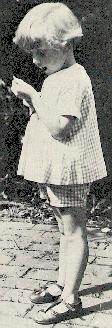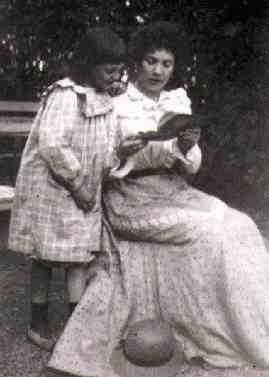Material Used in Boys' Clothing: Gingham
Gingham is a plain-woven fabric, initially made exclusively od cotton fabric. The strongm seviceable nature of the fabric makes its ideal for children's summer
clothing. It has been worn more by girls than boys, but French and other European boys did wear gingham smocks in the first half of the 20th century. Some of the
bows worn by boys in the late 19th century appear to have been made of gingham fabric.
Description
Gingham is a plain, yarn-dyed fabric commonly woven in a checkered pattern, but also in a stripped or plaid pattern or even in a solid color.
Etimology
The word "gingham" is derived from the Malayan "genggang," meaning stripped. It was introduced into the English language by French (Breton) weavers who referred to is "guingan," a term they applied to indicate cloth made from stripped coloring. Today in French ginham is called "vichy"--presumably because Vichy became a manufacturing center for the cloth. We are unsure about the proper term in French, German, Italian, and other languages.
Production
Gingham derives its trademark color and pattern effect from carded or combed yarns. Medium or fine yarns of varying quality are used to obtain the plain, checkered, or stripped effects. A gingham fabric differs from printed and other checkered or plaid fabrics in that its colored lines, which are made of warp yarns, are always on the grain. Thus gingham fabrics have no right and wrong side with respect to color. The warp and weft, or filling, may be the same, even-sided, or balanced. A plain weave, with an equal or unequal number of warp and filling yarns, is used for most ginghams.
Fibers
Gingham was originally made of cotton fibers. A variety of fibers came to be used for gingham.
Cotton: Cotton ginghams are made of combed or carded yarns.
Polyester and cotton: Blended fibers are used for wrinkle-resistant and durable press fabrics.
Wool: Wool yarn-dyed fabrics in plain weave are usually called "wool plaid" or "wool check" or are given fashion names such as "shepherd's check".
Chracteristics
Gingham is strong, substantial, and serviceable. It launders easily and well, but lower-textured fabric may shrink considerably unless preshrunk. Gingham is made in many weights such as sheer, medium, or heavy. There are a wide range of price levels for the various grades of gingham fabric. Designs and patterns vary from conservative to gaudy.
Uses
Uses include dress goods, trimmings, handkerchiefs, aprons, children's wear, and beachwear. Gingham is especially popular in summer dress wear for women and children. For children, gingham has been more used for girls than boys.
Girls clothes
Gingham has been used for a wide range of girls clothes:
Dresses: Gingham was a popular choice for summer dresses.
School uniform: Many schools have adopted gingham dresses for a school uniform. A student at the Foulds School (U.K.) remembers, "The school uniform was also introduced in 1950. It was green and white as now. Previous to this there was no school uniform due to war and general poverty. Mrs Bliss particularly remembers her gingham dress. They also had to wear green blazers and a cap or beret. She remembers being told off if you didn't wear it." At Toorak College (Australia), the present-day uniform was introduced by Miss
Allen during the war years (early 1940s). Summer uniform became a blue gingham dress and the winter uniform was made out of a specially woven cloth of navy blue wool with fine
red and gold vertical stripes. The red hat, still a feature of the Junior School uniform was first worn so that Toorak College students could be easily recognised on school
walks to Arthur's Seat.
Smocks: Girls wore gingham smocks. Smocks in the early 20th century were worn by girls and boys. I'm not sure how common the gingham smocks were as compared to smocks made from other material.

Figure 2.--These Australian boys in the early 1990s wear ginham shirts. Click on the image for a better view of the shirts. |
Boys clothes
Some boys also wore some gingham items.
Rompers: Rompers were a popular style for younger chilren, bith boys an girls, in the 1920s. One of the fabrics use for rompers was ginham, usually blue and pink. They were widely worn in America, HBC is less sure about Europe.
Shirts: Probably the most common gingham garment worn by boys were shirts. Gingham shirts were common in the first half of the 20th century.
Smocks: French and other European boys, even some European boys, however, might wear gingham smocks in the first half of the 20th century. I believe, for examole, I have seen photographs of Christoper Milne, AA Milne's son wearing gingham smocks. Christopher was of course the inspiration for Christopher Robin and Winnie the Poo. The son of French journalist Emil Zola also wore ginham smocks.
Bows: Some of the large bows worn by boys in the late 19th century apear to have gingham patterns.
Special Types
Gingham is made in some special types:
Chambray: Chambray is a type of gingham that has a solid color or appears to change color. It is produced by using colored warp and filling yarns of a different color, usually white.
Madras: Madras is a gingham in colors and patterns that originated in various parts of India--particularly Madras.
Shagbark: Shagbark gingham is plainwoven, but has tiny loops scattered over the surface that are produced by slack tension weaving.
Tissue gingham: When woven with fine yarns, it is called "tissue gingham".

Figure 3.--Christopher Milne of Winnie the Poo fame wore summer smocks until he began boarding school a 8 years old. He was teased by the other boys for being Christopher Robin. |
Smocking
Gingham also influenced a style of smocking. This style evolved from smocking on gingham, is called counterchange smocking where you use striped fabric, gingham or dotted
fabric, and mark where you place your stitches. The history of Counterchange in America has an interesting place in pre and post civil war southern life and has advanced greatly in the past 10 years into a unique form of picture smocking without cables. A counterchange design plate by Ann Halley, a smocking designer responsible for bringing counterchange to all of
our attention, called "Ring around the Rosey". As you can see the designer utilized and manipulated the uniformity of striped fabric to create teddy bears, waves and hearts.
Countries
HBC has little informational on national trends at this time. We do know that gingham was wideky used in America during the late 19th and eraly 20th centuries, but more for girls than English clothing. Gingham was also widely used in France. Ginham smocks were a popular garment. A HBC reader whose parents operated a clothing factory, tells HBC that parents used large quantities of gingham. in their factory.
Questions
Gingham is an important fabric and widely used for children's clothing. We hope to eventually expand this page with a fuller treatment of this subkect. There appears to be some reader interest on the sunject of gingham. HBC has received reader querries concerning gingham that we have been unable to answer. We would, however, be interested in any insights other readers may have.
One HBC reader asks, "I am trying to determine what is the gingham that has small flower bouquet motiffs within the plaid. I thought this was the original or traditional gingham, not just the plaid as shown on your site. I hope you can help me find out what that gingham is. Thanks in advance for your interesting site." [Fran Carpenter]
Another reader writes, "Great site, had a wonderful time going through it and
will go through it again and again. I have a question about the date of the first time gingham was made, do you know? Would it be the 18th century or earlier? Is it an Indian fabric style as it was cotton it was first made into? Also do you have more information about gingham smocking than what is on your site? I'm working on an article about gingham smocking and so am looking for more info." [Beth-Katherine Kaiman]
Christopher Wagner
Navigate the Boys' Historical Clothing Web Site:
[Return to the Main material page]
[Introduction]
[Activities]
[Biographies]
[Chronology]
[Clothing styles]
[Countries]
[Bibliographies]
[Contributions]
[Essays]
[FAQs]
[Glossaries]
[Satellites]
[Tools]
[Boys' Clothing Home]
Navigate the Historic Boys' Clothing Web chronological pages:
[The 1840s]
[The 1900s]
[The 1930s]
[The 1940s]
[The 1950s]
[The 1960s]
[The 1970s]
[The 1980s]
[The 1990s]
Created: September 26, 2000
Last updated: August 2, 2002


